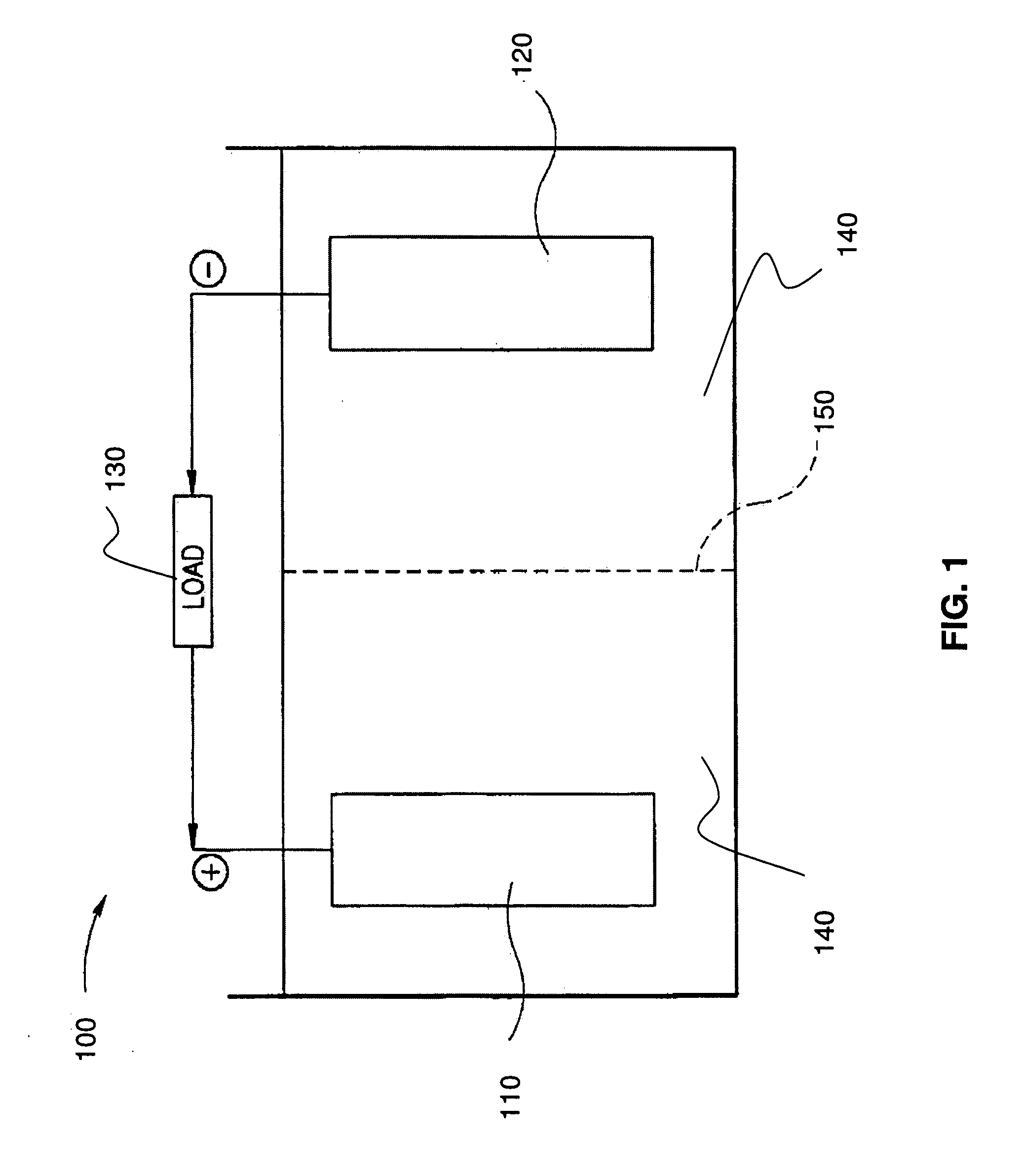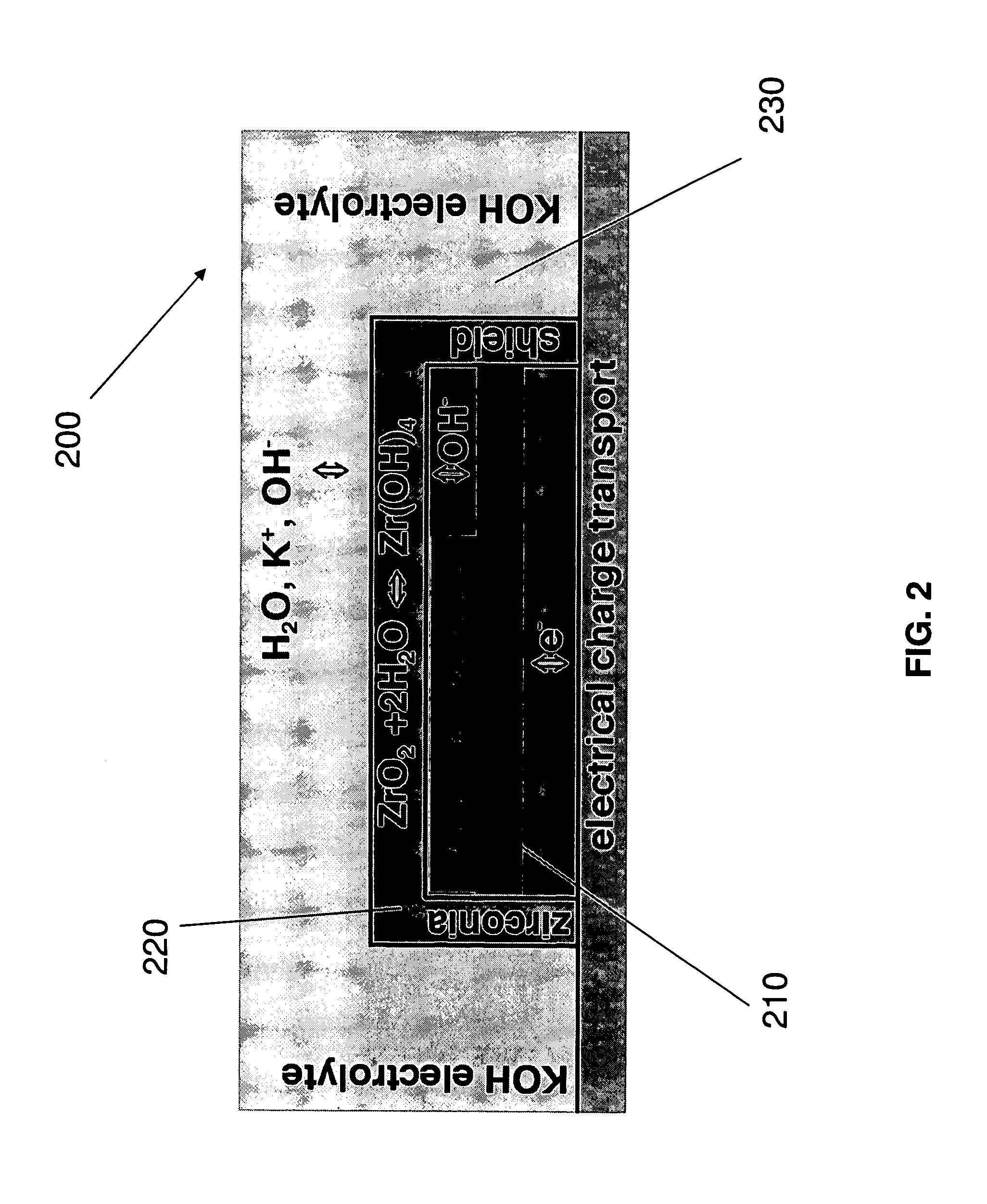Stabilized electrodes for electrochemical cells
a technology of electrochemical cells and stabilized electrodes, applied in the field of electrochemical cells, can solve the problems of portability constraints of devices, several obstacles are evident in the implementation of boride anodic chemistry,
- Summary
- Abstract
- Description
- Claims
- Application Information
AI Technical Summary
Benefits of technology
Problems solved by technology
Method used
Image
Examples
example 1
Comparative Discharge of Conventional, Super-Iron Cathode, and Boride Anode, Alkaline Batteries
[0043]FIG. 3 compares the discharge of alkaline electrolyte cells containing various anode and cathode couples. Anodes were studied in cells with excess intrinsic cathode capacity, in a 1 cm button cell, discharged under the indicated constant ohmic load conditions. Cells contained a (conventional) MnO2 cathode / Zn anode, or a K2FeO4 cathode, and / or a boride anode, and a KOH electrolyte. The boride anode was either TiB2 (Aldrich 10 μm powder) or VB2 (Aldrich 10 μm / 325 mesh powder), and contained 75% of the boride salt, 20% 1 μm graphite (Leico), 4.5% KOH and 0.5% binder (T-30, 30% teflon). The anode mixture was compressed onto a piece of graphite foil (Alfal Aesar). The K2FeO4 cathode, and the button cell configuration, were prepared as described, for example, in Example 4 below.
[0044]It is evident that the MnO2 / boride cell generates 0.2-0.3 V lower discharge potential, while the potential...
example 2
Comparative Discharges of Titanium or Vanadium Boride Anode Alkaline Batteries with a Variety of Cathodes
[0046]With reference to FIG. 4, comparative discharges of titanium (top) or vanadium (bottom) boride anode alkaline batteries with a variety of cathodes, under (left) anode limited or (right) cathode limited conditions were studied. In each case, 1 cm button cells were discharged at a constant 3 kΩ load conditions. The TiB2 or VB2 anodes used were as described in Example 1 above. The cathode was either (square symbol) 76.5% ZrO2 coated K2FeO4, 8.5% AgO, 5% KOH and 10% 1 μm graphite; or (circle) 90% MnO2 (EMD, EraChem K60) and 10% 1 μm graphite; or (triangle) NiOOH (from a commercial Powerstream Ni-MH button cell); or (diamond) 75% KIO4 (ACROS) and 25% 1 μm graphite. Anode, or cathode, limited conditions were studied by packing each cell, respectively, with excess intrinsic cathode, or anode capacity.
[0047]FIG. 4 probes the boride anode cells, not only under anode-limited, but al...
example 3
Capacity (Anode+Cathode) of the Super-Iron Boride Alkaline Battery Compared to the Conventional (Manganese Dioxide / Zinc) Alkaline Battery
[0050]The super-iron boride cell which was used contained either a titanium, or a vanadium, boride anode, as indicated in FIG. 5. The cathode was 76.5% K2FeO4, 8.5% AgO, 5% KOH and 10% 1 μm graphite. Charge retention (stability) of the cells were compared freshly discharged, and after 1 week storage, with, or without, a 1% zirconia coating applied to the Fe(VI) or boride salts.
[0051]The range from practical to theoretical (2F per Zn+2MnO2), maximum capacity of the conventional alkaline battery is shown as dashed vertical lines in FIG. 5. The theoretical capacity for the Fe6+ / B2− chemistry varies with the super-iron and boride counter ion. Here, the titanium boride (6F per TiB2+2K2FeO4) and super-iron vanadium boride (33F per 3VB2+11K2FeO4) chemistries yield an intrinsic 345 and 369 mAh / g, and are higher than the intrinsic MnO2—Zn capacity of 222 m...
PUM
| Property | Measurement | Unit |
|---|---|---|
| electrochemical potential | aaaaa | aaaaa |
| voltage | aaaaa | aaaaa |
| electrochemical potential | aaaaa | aaaaa |
Abstract
Description
Claims
Application Information
 Login to View More
Login to View More - R&D
- Intellectual Property
- Life Sciences
- Materials
- Tech Scout
- Unparalleled Data Quality
- Higher Quality Content
- 60% Fewer Hallucinations
Browse by: Latest US Patents, China's latest patents, Technical Efficacy Thesaurus, Application Domain, Technology Topic, Popular Technical Reports.
© 2025 PatSnap. All rights reserved.Legal|Privacy policy|Modern Slavery Act Transparency Statement|Sitemap|About US| Contact US: help@patsnap.com



